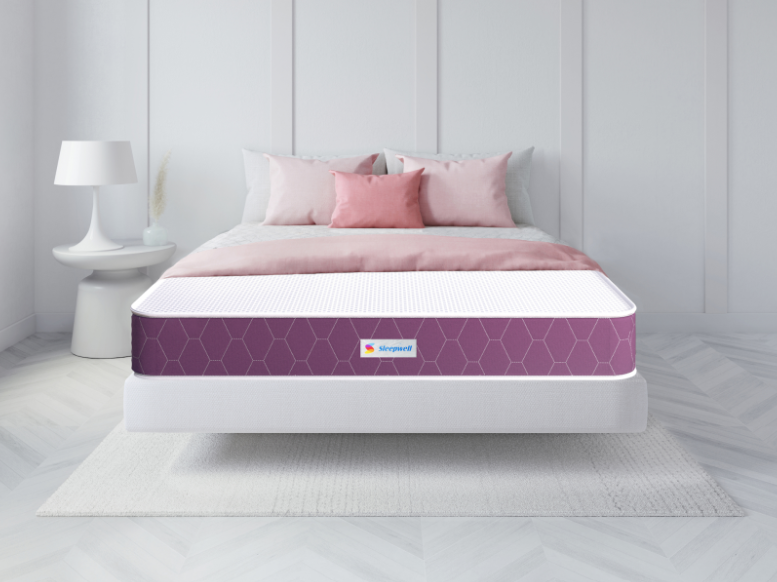Quality sleep often serves as the bedrock of health, productivity and overall well being. However, for those enduring back pain, getting a good night’s sleep, which is refreshing, is truly challenging. Selecting the best mattress for back pain that specifically aims to relieve tension and facilitate alignment proves pivotal. This blog aims to explore factors those with back discomfort should evaluate when selecting a mattress tailored to their therapeutic needs and sleep priorities.
Mattress composition and construction either alleviate or exacerbate pressure points and muscle strain based on ability to uniformly support natural curvature of the spine. With back pain sufferers, a supportive mattress matches contours while keeping the spine properly aligned. It basically relaxes the body into healthy positions for maximum rest and recovery overnight. An unsuitable mattress risks uneven weight distribution, awkward spinal positioning and tension buildup.
Unfortunately back pain afflicts vast populations worldwide at alarming rates. Beyond acute discomfort, consequences extend across overall wellness due to the deep links between restorative sleep and whole body homeostasis. Back pain frequently disrupts both sleep duration and quality via an inability to get comfortable plus persistent discomfort. This cyclically exacerbates pain levels and irritability over subsequent days.
This blog will offer a comprehensive guide to the best mattress for back problems. The overarching aim is to equip back pain sufferers with the understanding necessary to select durable mattresses engineered specifically to nurture spinal health during sleep.
What is the Relationship Between Sleep Quality and Back Pain
Sleep quality and back pain exist in a bidirectional relationship, with each capable of substantially impacting the other. When back pain disrupts an individual’s sleep continuity, consequences often include increased daily fatigue, mood changes like irritability, and cognitive difficulties concentrating. Conversely, poor sleep quantity or quality due to discomfort can exacerbate underlying back problems.
Specifically regarding effects on sleep, back pain frequently hinders the ability to find a comfortable sleeping position, resulting in restless nights characterized by recurrent awakenings. The onset of pain also elevates sensitivity to discomfort, producing a self-perpetuating feedback loop where escalating pain disturbances further disrupt sleep, which then aggravates pain intensity. Daytime effects of this vicious cycle manifest through lessened workplace or academic productivity plus strained interpersonal functioning and an overall reduced quality of life.
An incompatible mattress often critically exacerbates back pain issues by failing to provide proper spinal support or adequately alleviate focused pressure points. Deficient structural reinforcement allows poor sleeping posture misaligning the spine, creating muscular tension and nerve pain. Similarly, inadequate cushioning or contouring around prominent bony areas like the shoulders and hips can concentrate force, irritating nerves and dramatically increasing discomfort. Excessively soft mattresses also risk harmful curvature of the back, while poor motion isolation transfers movement across the bed, interrupting recuperative rest.
Thus sleep quality and spinal health fundamentally interrelate, with each capable of influencing the other either positively through restorative alignment or negatively via recurring pain and restless nights. This scientific link underscores the dire necessity of an ergonomic mattress facilitating spinal wellness rather than aggravating muscular strain or pressure points. An optimal mattress aims to relieve immediate discomfort while simultaneously preventing exacerbations over subsequent nights through sustained therapeutic support.
Factors to Consider When Choosing a Mattress for Back Pain
Several key aspects should guide your mattress selection process when seeking to alleviate back pain and improve sleep quality. These include:
Proper Spinal Support: Achieving healthy spinal alignment proves fundamental for back pain relief, with a supportive mattress facilitating the spine’s natural curvature and reducing muscle/ligament strain. Ideal firmness levels differ based on individual factors like sleeping positions, body types, and precise pain locations. Challenging blanket assumptions, personalized needs and varying pain levels necessitate eschewing one-size-fits-all notions of mattress firmness.
Material Options: Different mattress materials provide distinct advantages for back pain:
– Memory Foam: Renowned contouring ability molds to the body shape, aligning the spine while relieving pressure points.
– Latex Foam: Balances responsiveness with comfort through buoyant support preventing excessive sinkage.
– Innerspring: Traditional spring mattresses offer bounce yet may lack adequate reinforcement for some.
– Hybrid: Integrating multiple materials, commonly combining foam comfort layers above an innerspring support core.
Number of Internal Layers: A mattress’ thickness and layered construction impact spinal support and comfort. Thicker models allow more layered components like distinct comfort and transitional layers stacked above the core – all contributing to alignment and pressure relief. Familiarity with these layers proves useful when selecting an optimal individualized mattress.
Isolating Partner Disturbances: When looking for the best mattress for back pain, it is essential to understand that sleep disruptions caused by a partner’s movement can heighten discomfort and undermine restorative rest. As an example, there are multiple mattresses from Sleepwell, which are made of memory foam or latex and excel at damping motion transfer and allowing uninterrupted sleep, with “zero partner disturbance” an innovative goal of these mattresses seeking to facilitate unbroken sleep.
Temperature Regulation: Temperature affects sleep quality, with excess heat or cold exacerbating pain. Advanced technologies like gel-infusions, open-cell structures and breathable materials better regulate heat across the night, providing a more comfortable environment for back pain.
Carefully weighing these critical decision factors empowers the individual to select from different types of mattresses a specific one matching their precise back support requirements and sleep preferences – ultimately providing substantive pain relief while enabling healthier rest.
Choosing the Optimal Mattress Type for Different Back Pain Conditions
Mattresses for Lower Back Pain Relief
Lower back pain often necessitates balancing lumbar support with targeted pressure relief. Ideal mattresses for lower back issues maintain the spine’s natural alignment while alleviating strain concentrated in the lumbar region.
- Firmness Recommendation: Medium-firm models typically suit most lower back pain sufferers, supplying reinforcement without rigidity.
- Preferred Materials: Memory foam and latex uniquely contour to the body’s shape while supporting healthy spinal positioning.
- Lumbar Support: Mattresses with focused lumbar support regions effectively reduce lower back pressure points.
Mattress Qualities for Upper Back & Neck Support
Those struggling with upper back and neck pain need mattresses facilitating cervical alignment while alleviating escalating tension in upper spinal musculature.
- Specialized Recommendations: Medium to medium-firm comfort levels paired with contouring foams assist neck and upper back positioning.
- Advantageous Materials: Buoyant latex or hybrid mattresses furnish contouring assistance, defending against neck overextension injuries.
- Essential Pillow Pairing: Supportive pillows defending optimal neck angles prove fundamental for multi-faceted spinal wellness.
Mattress Criteria for Chronic Pain & Sciatica
Chronic back discomfort and sciatic neuralgia require specialized mattresses delivering enduring pain relief alongside focused pressure point reduction across nights.
- Customizable Support Systems: Models integrating adjustable comfort zones or modular components accommodate evolving support needs.
- Pain Relief Materials: Memory foams with supplemental lumbar reinforcement areas effectively counteract localized spinal strain.
- Balancing Cushioning & Support: Medium-firm central layers topped with plush surface materials supply necessary cushioning for persistent issues.
Carefully evaluating highly individualized criterions facilitates discovering mattresses nurturing specific orthopedic healing, spinal alignment, and tranquil rest.
Recommendations for Mattress Selection Process
Selecting optimal mattresses for back pain alleviation requires moving beyond passive review reading or generalized advice to instead emphasize hands-on testing attuned to unique body insights. Useful suggestions include:
- Prioritize Personal Experience: Everyone possesses specialized sleep preferences and pain profiles – direct testing allows assessing customized support.
- Evaluate Comfort plus Support: Extended mattress trials enable gauging spinal alignment provision alongside targeted pain area cushioning.
- Evaluate Sleep Quality Impacts: Direct home testing helps judge impacts across nights – evaluating comfort, support, and rest restoration.
Strategies for In-Store and Online Testing
In-Store Testing Tips
- Allow Ample Assessment Time: Lie down for extended 15-minute sessions evaluating appropriateness.
- Vary Testing Positions: Mimic actual sleeping positions to check multi-positional appropriateness.
- Engage Staff Expertise: Consult sales associates regarding construction specifications and back pain suitability.
Online Testing Considerations
- Research Extensively: Leverage customer evaluations, product details, and material specifications to understand pain relief potentials.
- Look for Trial Offers: Target brands offering lengthy home testing periods or flexible return timelines.
- Utilize Virtual Tools: Some companies offer virtual mattress fitting tools or quizzes to match your preferences with suitable mattress types. A good example would be the mattress selector tool Sleepwell provides on its website. It asks you a few questions and finally suggests the best mattress for back pain or any other specific requirement that you may have.
Testing mattresses, either in stores or online, can help you make a confident decision when choosing a mattress that best relieves back pain. Understanding return policies and warranties gives you peace of mind.
Selecting the right mattress is key for back pain relief. It requires fully grasping what makes a mattress provide restful, pain-free sleep. A suitable mattress is an important health investment, not just a comfort purchase.
Back pain disrupts sleep for many people globally, causing escalating discomfort and poor rest. Recognizing the link between back health and quality sleep shows the value of picking a mattress that properly supports the back and reduces pain. Leading mattress companies design models specifically to align the spine and address back pain.
Factors like spinal support, mattress materials, thickness, motion isolation, and temperature control significantly impact back pain suitability. Knowing these criteria focuses an individual’s search to match their orthopedic needs.
Finding the best mattress for back pain and to improve sleep is a personal journey. With the insights provided here, one can confidently choose one from different types of mattresses available in the market. Choose a mattress that lowers pain, cares for the spine, and restores rejuvenating rest, supporting overall wellness.

